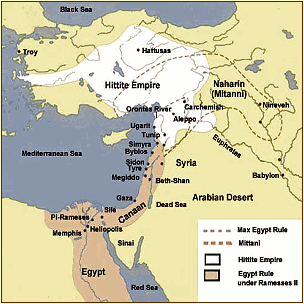|
|
|

Pages in this article: [ THE LIFE OF RAMESSESS THE GREAT ] [ THE EARLY YEARS ] [ NEFETARI ] [ RAMESSESS THE WARRIOR ] [ BATTLE OF KADESH ] [ RAMESSES THE GOD ] [ RAMESSES THE BUILDER ] [ DEATH OF A GOD ]
The battle of Kadesh - events leading up to the battle
A coalition between the forces of Hatti, Anotolia and Syria decided to wage war on Egypt and attacked Egypt's northern territories.
|
The Hittite king Muwatallis led the enemy force, of two contingents each of 18,000 men supported by at least 2,500 charioteers. However these figures are unsubstantiated. Ramesses's military prowess would be tested when he fought for Egypt's existence, confronting the coalition's huge army on the Syrian plain, at the battle of Kadesh.
|
|
|
At the age of 25, Ramesses was the commander of the largest professional army of the ancient world. His army comprised of infantry regiments and mercenaries, most noticeably, the Sherden who were a fierce sea faring people, renowned for their piratical raids and their distinctive armour, along with a contingent of Nearin. The Nearin were to play a pivotal role in the forthcoming battle, left at Amurru by Ramesses acting as his rearguard.
|
|
|
Supplementing Ramesses army were squadrons of chariots, acquisitions from the Hyksos. Typically, the Egyptians adapted the design to meet their requirements, changing the original heavy frame to one constructed from ash; its properties would give the chariot lightness and strength. For speed and manouverability, two horses pulled the chariot manned by a two-man crew consisting of a driver and an archer.
|
|
|
This combination made the Egyptian chariot a formidable fighting machine best suited to fast, long range assaults, similar to today’s modern Light Infantry. Unlike the Hittite chariot, which was large, slow, heavy and best suited to short face to face assaults.
|
The battle of Kadesh - what was at stake?
 The domination of the Syrian plain, with its trade routes between the Euphrates and the Mediterranean was at stake with the added bonus of untold wealth from Egypt. Hostilities between the Hittites and Egypt had raged since the 17th Dynasty, with several pharaohs leading victorious military expeditions into Syria to quell Hittite uprisings. Ramesses was determined to quell this latest uprising once and for all. The domination of the Syrian plain, with its trade routes between the Euphrates and the Mediterranean was at stake with the added bonus of untold wealth from Egypt. Hostilities between the Hittites and Egypt had raged since the 17th Dynasty, with several pharaohs leading victorious military expeditions into Syria to quell Hittite uprisings. Ramesses was determined to quell this latest uprising once and for all.
The Battle: day 1
In the spring of 1274 BC, recorded as regnal year 5, day 9, 2nd month of summer of his reign, Ramesses marched eastwards with a force of 20,000 troops and charioteers through Gaza, Canaan and Syria to confront the coalition at Kadesh.
The army was split into four divisions each marching under the protective banner of a god: Amun which, was personally led by Ramesses, Re, Ptah and Seth. After a months marching, Ramesses's army reached Canaan where they briefly halted, and then moved swiftly on to Shabtuna, some ten miles from Kadesh. Pressing his advantage, Ramesses closed up to the outskirts of Kadesh itself. It was here that the army decided to make camp, in the wood of Labwi.
Whilst patrolling the woods, the Egyptian guards came across two Shosu Bedouin who confessed under interrogation to being Hittite deserters and knew the location of the Hittite army. They revealed that "the enemy from Hittie is in the land of the Khaleb, to the north of Tunip at Aleppo" situated some 200 miles to the north of Kadesh.
However these Bedouin were spies, deliberately supplying Ramesses with false information. Ramesses eager to take the Hittitess by surprise, led the division of Amun way ahead of his army, crossing the river Orontes to set up camp on a knoll to the north-west of Kadesh, summoning for his travelling throne to be set up so as to observe the city.

This tactical error left the divisions strung out over a distance of some miles with the division of Amun isolated and unprotected.
Once again, the Egyptian guards captured two wandering Bedouin who were obviously Hittite spies. The spies were encouraged to divulge the location of their army, and believing that the coalition was miles away, Ramesses was not unduly worried. This was soon to change. The spies confessed: "Lo! The king of Hatti has already arrived ... they stand armed and ready for battle behind the old city of Kadesh."
Ramesses immediately summoned his generals, demanding to know why he had not been advised of the situation, and blaming his rashness on his subordinates who in turn placed the blame firmly on the Egyptian intelligence service. A runner was immediately dispatched to summon the other three divisions. Ramesses's eagerness for victory had led his army right into Muwatallis's trap.
|
Muwatallis bided his time and waited until the three divisions of Re, Ptah and Seth who were spread out on either side of the Orontes River.
At precisely this moment the Hittite chariots came pouring down out of the woods to attack Re division, quickly turning round to directly attack Ramesses camp.
Taken by surprise the soldiers forgot all their military training and scattered being cut down as they went, those that did escape ran northwards leading the Hittite chariots straight into Ramesses camp.
|
|
It was now the turn of Ramesse’s personal guard of Amun to be taken by surprise and scatter.
With chaos reigning all around him Ramesses called upon his father Amun to come to his aid. Ramesses is filled with the power of Amun and feels his chest swell and his heart grow stout.
Donning his armour, and believing he was invincible, Ramesses jumps into his chariot and rides straight into the enemy who scatter in fear of him.
The king tries to rally his troops by crying out:
|
|
|
|
| |
|
"Stand firm, steady your hearts my army. That you may behold my victory, I am alone, but Amun will be my protector, his hand is with me."
|
Inscriptions written after the battle describe Ramesses actions thus; He (Ramesses) single handed attacked and defeated the surprised Hittites "being more efficient than millions of foot soldiers and ten thousand of chariots."
Fate is on Ramesses side. The Nearin troops left at Amurru play a crucial role at Kadesh. As part of a predetermined battle plan, the elite troops would attack Kadesh from the rear through the Eleutheros Valley. Their fortuitous (and no doubt timely) unexpected arrival on the battle field took Muwatallis completely by surprise. Altering the sway of the battle away from the Hittites to the Egyptians; allowing Ramesses to take advantage of the situation, charging into the Hittite ranks six times, slowly forcing the Hittite chariots back across the Orontes.
|
Textual evidence describes the role played by the Nearin thus, "The Nearin smashed into the vile Fallen One of Hatti, just as it was on the point of entering pharaoh's camp."
|
|
|
|
The Nearin's arrival rallied Ramesses's troops as the text continues: "The entourage of his Majesty killed them, not allowing any to escape.". By now the division of Ptah arrived on the scene along with the deserters of Re and Amen, Seth division arriving somewhat later, allowing the Egyptian camp to settle down for the night.
|
The Battle: day 2
What actually took place in the morning is uncertain. The Egyptian account tells us that in the morning, Ramesses's army attacked the Hittites where it's claimed "The dead lay in heaps in their own blood."
|
The reality of the situation was probably different. Facing one another on the Syrian plain stood the two greatest armies the world had ever seen, both used to a different type of warfare, both used to overthrowing a weaker adversary, town by town, until beaten into submission.
Neither was probably used to actually facing a well disciplined army face to face. Moreover, with both sides staring defeat in the face, neither side willing to accept defeat, the result was a stand off.
|
King Muwatallis could stand the bloodshed no longer, and probably realising that neither side could win the battle, he sent a letter pleading for peace saying:
"Do not be hard in your actions, victorious king, peace is better than fighting, give us time to breathe."
|
Negotiations were entered into, with King Muwatallis wanting a peace treaty but Ramesses would have none of it and only agreed to sign a truce. Ramesses's megalomania saw this stand off between the two nations as a personal victory and returned home to have his dubious victory commemorated. The battle was re-enacted in relief carvings on all Egypt's major monuments.
Whether this stand off was seen as a decline in the reputation of the Egyptian army is uncertain. Instead of bringing peace to the area, the contrary appears to have happened. For the next 16 years, Ramesses's army would have to quell uprisings in Canaan, Syria, Amurru, Phoenicia and Dapur.
Three events occurred that would change the situation between the two nations for ever:
|
The first being the death of king Muwatallis, occurring in year 8-9 of Ramesses's reign. His death led to a power struggle within the Hatti royal court, with his son Urhi-Teshnub succeeding him, ruling as Mursilis II. Mursilis II was usurped by his uncle Hattusilis, a war-monger, who had designs on conquering Egypt.
|
|
|
|
Secondly, in year 18-19 Urhi-Teshnub sought refuge in Egypt, where upon Hattusilis requested his deportation, which Ramesses flatly refused. Tensions ran so high, that it led the two countries to the brink of hostilities, almost to the point of repeating Kadesh.
|
|
|
|
Thirdly, a new powerful nation was sweeping across the Levant, the Assyrians. They had already over thrown the Mitanni Empire and were now threatning to invade Hatti. Hattusilis, an experienced diplomat, could see the sense of forming an alliance with Egypt, as it would be mutually beneficial for one another. In regnal year 21 a peace treaty was agreed to, inextricably tying the two nations to everlasting peace. This momentous occasion was sealed and inscribed on two matching silver tablets.
|
The treaty
Before Ramesses would agree to sign the treaty, he had the opening lines of it re written, making it clear that he held the Hittites responsible for the breaking of the original agreement signed between Akhenaten and Suppiluliumas.
Secondly, it was a pact of non-aggression and mutual assistance if attacked by a third party (i.e. Assyria) and the extradition of political opponents (an obvious reference to the Urhi-Teshnub incident).
Thirdly, it defines the country's borders and provides assistance in the case of internal revolution. The treaties were witnessed by "a thousand sacred gods of Egypt and a thousand sacred gods of Hatti, who will cause him to flourish and will make him live, together with his household, his land and his servants."
The agreed text is recorded to having been received in Piramesses on "regnal year 21, 21st day, 1st month of winter." c. 1259 BC. Copies of the treaty were inscribed on the walls of Karnak Temple and the Ramesseum.
|
Twelve years after the treaty had been signed and to prove that this was a permanent agreement, Hattusilis III sent his eldest daughter as a bride to Ramesses. She arrived "year 34, 3rd month of winter" ( c. 1246-1245 BC) and was accepted into Ramesses's harem as Mahor-Neferure, "she is one who sees Horus, the beauty of Re".
A few years later, year 44, another one of Hattusilis daughters was sent for Ramesses to marry, an action that can only be described as a bribe, as a means of securing the continued allegiance between the two countries.
|
The Hittite version of the treaty was erected at Hattusas, the capital of Hatti, and was written in cuneiform, the preferred language for international diplomacy.
As a gesture of entente cordial, the queens of Hatti and Egypt, Puduhepa and Nefertari respectively, sent one another congratulatary gifts and letters.
|
Next: Ramesses the god >>
|
|
|







 The domination of the Syrian plain, with its trade routes between the Euphrates and the Mediterranean was at stake with the added bonus of untold wealth from Egypt. Hostilities between the Hittites and Egypt had raged since the 17th Dynasty, with several pharaohs leading victorious military expeditions into Syria to quell Hittite uprisings. Ramesses was determined to quell this latest uprising once and for all.
The domination of the Syrian plain, with its trade routes between the Euphrates and the Mediterranean was at stake with the added bonus of untold wealth from Egypt. Hostilities between the Hittites and Egypt had raged since the 17th Dynasty, with several pharaohs leading victorious military expeditions into Syria to quell Hittite uprisings. Ramesses was determined to quell this latest uprising once and for all.